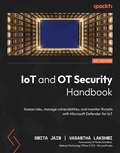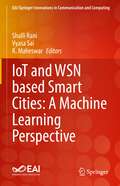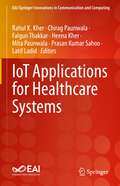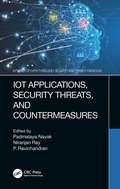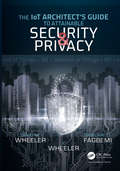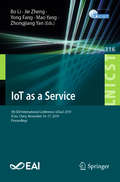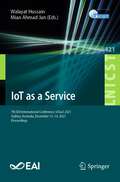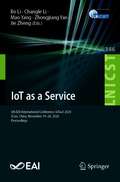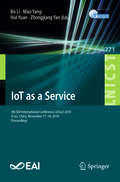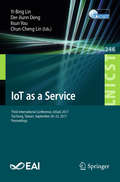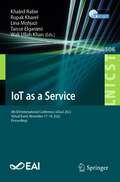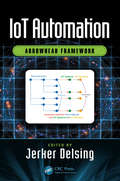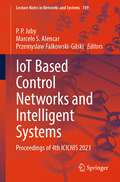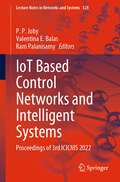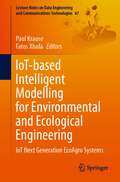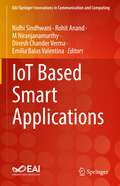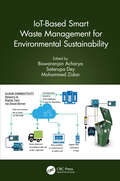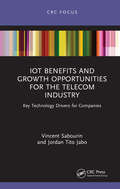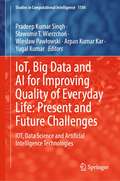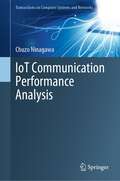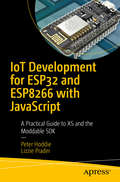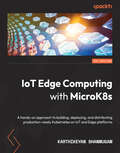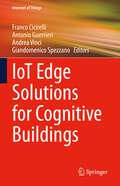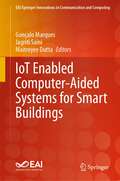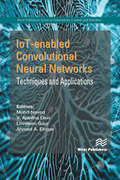- Table View
- List View
IoT and OT Security Handbook: Assess risks, manage vulnerabilities, and monitor threats with Microsoft Defender for IoT
by Smita Jain Vasantha Lakshmi Dr Rohini SrivathsaLeverage Defender for IoT for understanding common attacks and achieving zero trust for IoT and OT devicesPurchase of the print or Kindle book includes a free PDF eBookKey FeaturesIdentify and resolve cybersecurity challenges in the IoT and OT worldsFamiliarize yourself with common attack vectors in the IoT and OT domainsDive into Defender for IoT, understand its capabilities, and put it to practiceBook DescriptionThe Fourth Industrial Revolution, or Industry 4.0, is all about digital transformation, manufacturing, and production. The connected world we live in today, including industries, comes with several cybersecurity challenges that need immediate attention. This book takes you through the basics of IoT and OT architecture and helps you understand and mitigate these security challenges.The book begins with an overview of the challenges faced in managing and securing IoT and OT devices in Industry 4.0. You'll then get to grips with the Purdue model of reference architecture, which will help you explore common cyber attacks in IoT and OT environments. As you progress, you'll be introduced to Microsoft Defender for IoT and understand its capabilities in securing IoT and OT environments. Finally, you will discover best practices for achieving continuous monitoring and vulnerability management, as well as threat monitoring and hunting, and find out how to align your business model toward zero trust.By the end of this security book, you'll be equipped with the knowledge and skills to efficiently secure IoT and OT environments using Microsoft Defender for IoT.What you will learnDiscover security challenges faced in IoT and OT environmentsUnderstand the security issues in Industry 4.0Explore Microsoft Defender for IoT and learn how it aids in securing the IoT/OT industryFind out how to deploy Microsoft Defender for IoT along with its prerequisitesUnderstand the importance of continuous monitoringGet familiarized with vulnerability management in the IoT and OT worldsDive into risk assessment as well as threat monitoring and huntingAchieve zero trust for IoT devicesWho this book is forThis book is for industrial security, IoT security, and IT security professionals. Security engineers, including pentesters, security architects, and ethical hackers, who want to ensure the security of their organization's data when connected with the IoT will find this book useful.
IoT and WSN based Smart Cities: A Machine Learning Perspective (EAI/Springer Innovations in Communication and Computing)
by Shalli Rani Vyasa Sai R. MaheswarThis book provides an investigative approach to how machine learning is helping to maintain and secure smart cities, including principal uses such as smart monitoring, privacy, reliability, and public protection. The authors cover important areas and issues around implementation roadblocks, ideas, and opportunities in smart city development. The authors also include new algorithms, architectures and platforms that can accelerate the growth of smart city concepts and applications. Moreover, this book provides details on specific applications and case studies related to smart city infrastructures, big data management, and prediction techniques using machine learning.
IoT Applications for Healthcare Systems (EAI/Springer Innovations in Communication and Computing)
by Latif Ladid Falgun Thakkar Rahul K. Kher Chirag Paunwala Heena Kher Mita Paunwala Prasan Kumar SahooThis book discusses communications technologies used in the field of healthcare, including IoT, soft computing, machine learning, big data, augmented reality, and wearable sensors. The book presents various applications that are helpful for research scholars and scientists who are working toward identifying and pinpointing the potential of this technology. The book also helps researchers and practitioners to understand and analyze the e-healthcare architecture through IoT and the state-of-the-art in IoT countermeasures with real-time challenges. Topics of interest include healthcare systems based on advanced development boards, mobile health parameters recording and monitoring systems, remote health / patient monitoring, hospital operations management, abnormality / disease detection by IoT devices, and efficient drug management. The book is relevant to a range of researchers, academics, and practitioners working on the intersection of IoT and healthcare.
IoT Applications, Security Threats, and Countermeasures (Internet of Everything (IoE))
by Padmalaya Nayak Niranjan Ray P. RavichandranThe book explores modern sensor technologies while also discussing security issues, which is the dominant factor for many types of Internet of Things (IoT) applications. It also covers recent (IoT) applications such as the Markovian Arrival Process, fog computing, real-time solar energy monitoring, healthcare, and agriculture. Fundamental concepts of gathering, processing, and analyzing different Artificial Intelligence (AI) models in IoT applications are covered along with recent detection mechanisms for different types of attacks for effective network communication. On par with the standards laid out by international organizations in related fields, the book focuses on both core concepts of IoT along with major application areas. Designed for technical developers, academicians, data scientists, industrial researchers, professionals, and students, this book is useful in uncovering the latest innovations in the field of IoT.
The IoT Architect's Guide to Attainable Security and Privacy
by Damilare D. Fagbemi David M Wheeler JC WheelerThis book describes how to architect and design Internet of Things (loT) solutions that provide end-to-end security and privacy at scale. It is unique in its detailed coverage of threat analysis, protocol analysis, secure design principles, intelligent loT's impact on privacy, and the effect of usability on security. The book also unveils the impact of digital currency and the dark web on the loT-security economy. It's both informative and entertaining. "Filled with practical and relevant examples based on years of experience ... with lively discussions and storytelling related to loT security design flaws and architectural issues."— Dr. James F. Ransome, Senior Director of Security Development Lifecycle (SOL) Engineering, Intel 'There is an absolute treasure trove of information within this book that will benefit anyone, not just the engineering community. This book has earned a permanent spot on my office bookshelf."— Erv Comer, Fellow of Engineering, Office of Chief Architect Zebra Technologies 'The importance of this work goes well beyond the engineer and architect. The IoT Architect's Guide to Attainable Security & Privacy is a crucial resource for every executive who delivers connected products to the market or uses connected products to run their business."— Kurt Lee, VP Sales and Strategic Alliances at PWNIE Express "If we collectively fail to follow the advice described here regarding loT security and Privacy, we will continue to add to our mounting pile of exploitable computing devices. The attackers are having a field day. Read this book, now."— Brook S.E. Schoenfield, Director of Advisory Services at IOActive, previously Master Security Architect at McAfee, and author of Securing Systems
IoT as a Service: 5th EAI International Conference, IoTaaS 2019, Xi’an, China, November 16-17, 2019, Proceedings (Lecture Notes of the Institute for Computer Sciences, Social Informatics and Telecommunications Engineering #316)
by Yong Fang Bo Li Mao Yang Zhongjiang Yan Jie ZhengThis book constitutes the refereed post-conference proceedings of the Fifth International Conference on IoT as a Service, IoTaaS 2019, which took place in Xi’an, China, in November 2019. The 54 revised full papers were carefully reviewed and selected from 106 submissions. The papers contribute to the discussion on the challenges posed by Internet of Things (Io). The two technical tracks and three workshops deal in detail: Networking and Communications Technologies for IoT, IoT as a service, International Workshop on Edge Intelligence and Computing for IoT Communications and Applications, International Workshop on Wireless Automated Networking for Internet of Things, and International Workshop on Ubiquitous Services Transmission for Internet of Things.
IoT as a Service: 7th EAI International Conference, IoTaaS 2021, Sydney, Australia, December 13–14, 2021, Proceedings (Lecture Notes of the Institute for Computer Sciences, Social Informatics and Telecommunications Engineering #421)
by Walayat Hussain Mian Ahmad JanThis book constitutes the refereed post-conference proceedings of the 7th International Conference on IoT as a Service, IoTaaS 2021, which took place in Sydney, Australia, in December 2021. Due to COVID-19 pandemic the conference was held virtually. The 17 revised full papers were carefully reviewed and selected from 129 submissions. The papers are divided in content-related tracks: Intelligent IoT communication solutions; Social Internet of Things: security, management; Machine learning prediction and recommendation in IoT.
IoT as a Service: 6th EAI International Conference, IoTaaS 2020, Xi’an, China, November 19–20, 2020, Proceedings (Lecture Notes of the Institute for Computer Sciences, Social Informatics and Telecommunications Engineering #346)
by Bo Li Changle Li Mao Yang Zhongjiang Yan Jie ZhengThis book constitutes the refereed post-conference proceedings of the 6st International Conference on IoT as a Service, IoTaaS 2020, which took place in Xi’an, China, in November 2020. Due to COVID-19 pandemic the conference was held virtually. The 69 revised full papers were carefully reviewed and selected from 136 submissions. The papers present two technical tracks and three workshops: The Second Workshop on Edge Intelligence and Computing for Iot Communications and Applications, the Workshop on Satellite Communication Networks for Internet of Things, the Workshop on Satellite Communications
IoT as a Service: 4th EAI International Conference, IoTaaS 2018, Xi’an, China, November 17–18, 2018, Proceedings (Lecture Notes of the Institute for Computer Sciences, Social Informatics and Telecommunications Engineering #271)
by Bo Li Mao Yang Hui Yuan Zhongjiang YanThis book constitutes the refereed post-conference proceedings of the Fourth International Conference on IoT as a Service, IoTaaS 2018, which took place in Xi’an, China, in November 2018. The 50 revised full papers were carefully reviewed and selected from 83 submissions. The technical track present IoT-based services in various applications. In addition, there are three workshops: international workshop on edge computing for 5G/IoT, international workshop on green communications for internet of things, and international workshop on space-based internet of things.
IoT as a Service: Third International Conference, IoTaaS 2017, Taichung, Taiwan, September 20–22, 2017, Proceedings (Lecture Notes of the Institute for Computer Sciences, Social Informatics and Telecommunications Engineering #246)
by Yi-Bing Lin Der-Jiunn Deng Ilsun You Chun-Cheng LinThis book constitutes the thoroughly refereed proceedings of the 3rd International Conference on IoT as a service, IoTaaS 2017, held in Taichung, Taiwan, in September 2017. The 46 full papers were carefully selected from 65 submissions. The papers deal with the “Everything as a Service” deployment paradigm which enables the easy adoption of IoT based services and applications by end-users, and forces providers of smart objects and middleware platforms to architect their solutions accordingly. The three special sessions organized were Wearable Technology and Applications (WTAA), Building Smart Machine Applications (BSMA), and Security and Privacy in Internet of Things, Services and People (SP-IoTSP). The WTAA special session aimed to address the challenges of maintaining high efficiency of WTAA in terms of high recognition rate, energy consumption, computational costs and so forth. The BSMA special session aimed to explore how to construct smart machines architecture for the industry under the background of IoT and big data. The SP-IoTSP special session aimed to investigate recent research and future directions for IoTSP security and privacy.
IoT as a Service: 8th EAI International Conference, IoTaaS 2022, Virtual Event, November 17-18, 2022, Proceedings (Lecture Notes of the Institute for Computer Sciences, Social Informatics and Telecommunications Engineering #506)
by Khaled Rabie Rupak Kharel Lina Mohjazi Taissir Elganimi Wali Ullah KhanThis book constitutes the refereed proceedings of the 8th EAI International Conference on IoT as a Service, IoTaaS 2022 was held virtually due to the COVID-19 crisis.The 17 full papers and 10 short papers included in this book were carefully reviewed and selected from 50 submissions. They were organized in topical sections as follows: Next generation wireless networks, Internet of Things, Artificial Intelligence, Wireless Communications, Vehicular Networks, Resource Optimization, Satellite communications and Machine Learning, Network Security.
IoT Automation: Arrowhead Framework
by Jerker DelsingThis book presents an in-depth description of the Arrowhead Framework and how it fosters interoperability between IoT devices at service level, specifically addressing application. The Arrowhead Framework utilizes SOA technology and the concepts of local clouds to provide required automation capabilities such as: real time control, security, scalability, and engineering simplicity. Arrowhead Framework supports the realization of collaborative automation; it is the only IoT Framework that addresses global interoperability across multiplet SOA technologies. With these features, the Arrowhead Framework enables the design, engineering, and operation of large automation systems for a wide range of applications utilizing IoT and CPS technologies. The book provides application examples from a wide number of industrial fields e.g. airline maintenance, mining maintenance, smart production, electro-mobility, automative test, smart cities—all in response to EU societal challenges. <P><P>Features <li>Covers the design and implementation of IoT based automation systems. <li>Industrial usage of Internet of Things and Cyber Physical Systems made feasible through Arrowhead Framework. <li>Functions as a design cookbook for building automation systems using IoT/CPS and Arrowhead Framework. <li>Tools, templates, code etc. described in the book will be accessible through open sources project <li>Arrowhead Framework Wiki at forge.soa4d.org/ <li>Written by the leading experts in the European Union and around the globe.
IoT Based Control Networks and Intelligent Systems: Proceedings of 4th ICICNIS 2023 (Lecture Notes in Networks and Systems #789)
by P. P. Joby Marcelo S. Alencar Przemyslaw Falkowski-GilskiThis book gathers selected papers presented at International Conference on IoT Based Control Networks and Intelligent Systems (ICICNIS 2023), organized by School of Computer Science and Engineering, REVA University, Bengaluru, India, during June 21–22, 2023. The book covers state-of-the-art research insights on Internet of things (IoT) paradigm to access, manage, and control the objects/things/people working under various information systems and deployed under wide range of applications like smart cities, healthcare, industries, and smart homes.
IoT Based Control Networks and Intelligent Systems: Proceedings of 3rd ICICNIS 2022 (Lecture Notes in Networks and Systems #528)
by P. P. Joby Valentina E. Balas Ram PalanisamyThis book gathers selected papers presented at International Conference on IoT Based Control Networks and Intelligent Systems (ICICNIS 2022), organized by St. Joseph’s College of Engineering and Technology, Kottayam, Kerala, India, during July 1–2, 2022. The book covers state-of-the-art research insights on Internet of things (IoT) paradigm to access, manage, and control the objects/things/people working under various information systems and deployed under wide range of applications like smart cities, health care, industries, and smart homes.
IoT-based Intelligent Modelling for Environmental and Ecological Engineering: IoT Next Generation EcoAgro Systems (Lecture Notes on Data Engineering and Communications Technologies #67)
by Paul Krause Fatos XhafaThis book brings to readers thirteen chapters with contributions to the benefits of using IoT and Cloud Computing to agro-ecosystems from a multi-disciplinary perspective. IoT and Cloud systems have prompted the development of a Cloud digital ecosystem referred to as Cloud-to-thing continuum computing. The key success of IoT computing and the Cloud digital ecosystem is that IoT can be integrated seamlessly with the physical environment and therefore has the potential to leverage innovative services in agro-ecosystems. Areas such as ecological monitoring, agriculture, and biodiversity constitute a large area of potential application of IoT and Cloud technologies. In contrast to traditional agriculture systems that have employed aggressive policies to increase productivity, new agro-ecosystems aim to increase productivity but also achieve efficiency and competitiveness in modern sustainable agriculture and contribute, more broadly, to the green economy and sustainable food-chain industry. Fundamental research as well as concrete applications from various real-life scenarios, such as smart farming, precision agriculture, green agriculture, sustainable livestock and sow farming, climate threat, and societal and environmental impacts, is presented. Research issues and challenges are also discussed towards envisioning efficient and scalable solutions to agro-ecosystems based on IoT and Cloud technologies. Our fundamental belief is that we can collectively trigger a new revolution that will transition agriculture into an equable system that not only feeds the world, but also contributes to mitigating the climate change and biodiversity crises that our historical actions have triggered.
IoT Based Smart Applications (EAI/Springer Innovations in Communication and Computing)
by Nidhi Sindhwani Rohit Anand M Niranjanamurthy Dinesh Chander Verma Emilia Balas ValentinaThis book provides insights into IoT, its applications, and various implementation techniques. The authors first discuss the IoT design methodology to define the domain model. They then cover various connection methodologies used in IoT such as Ethernet, Wi-Fi, low powered wide area network (LPWAN), Bluetooth, RFID, cellular, and satellite, and more, along with their challenges. An example is made on the designing process using Arduino, which offers smart, connected, and secure elements; they also illustrate the integration of IoT with Blockchain, cloud, machine learning, big data, embedded software, sensors, etc. The book going on to cover the future of IoT in various sectors and how IoT will continue to be game-changing technology.
IoT-Based Smart Waste Management for Environmental Sustainability (Smart and Intelligent Computing in Engineering)
by Biswaranjan Acharya, Satarupa Dey, and Mohammed ZidanThis book consolidates and summarizes smart technologies like IoT, edge computing, and AI used in different aspects of waste material management, mitigation, and recycling for a sustainable environment. One of the cases explains how IoT-based systems and wireless sensors can be used to continuously detect common pollutants such as volatile organic compounds (VOCs), carbon monoxide, and particulate matter (PM) and how the data collected are used to assess the overall air quality and determine actions for improvements. A collection of practical case studies, this book provides a comprehensive knowledge in smart waste management to readers in universities, research centers, and industries.
IoT Benefits and Growth Opportunities for the Telecom Industry: Key Technology Drivers for Companies
by Vincent Sabourin Jordan Tito JaboThis critical and forward-looking book features: An assessment of the impact of Internet of Things (IoT) on the telecom industry’s revenue streams IoT-based business models in the telecom industry A PESTLE (political, economic, socio-cultural, technological, legal, and environmental) analysis of the industry in relation to IoT Key technological drivers. It also features a case study of Bell Canada Enterprises (BCE) Inc., which highlights IoT-based business models in the industry. The study reveals that telecom operators have started implementing IoT projects, however, true revenue streams are yet to materialize. Ten IoT-based business models have been identified at BCE Inc. The book points out that operators do leverage existing infrastructure in terms of broadband fiber and mobile connectivity in part and resort to partnerships and acquisitions to acquire much-needed knowledge, technology, and smart devices. Concerning the effect of IoT on the telecoms’ revenue streams, it was revealed that new entrants, who are not necessarily in the telecom industry, have impacted the old players’ revenue streams. OTT services like YouTube, WhatsApp, IPTV, Netflix, are the biggest culprits. Seven key technological drivers for IoT have been identified and include widespread wireless connectivity, the availability and affordability of microcontrollers, sensors and actuators, the decreasing cost of bandwidth, the recent implementation of IPv6, and the ongoing development of 5G network, as well as the use of cloud computing and analytics. Finally, the PESTLE analysis of the industry shows that the lack of a comprehensive political and regulatory framework still slows down IoT deployment. Interoperability, security, and privacy concerns are other constraints. Conversely, general economic conditions in most developed and developing economies are favorable to the advancement of IoT technology. Governments are willing to subsidize R&D and have partnered with the private sector to speed up the roll-out process.
IoT, Big Data and AI for Improving Quality of Everyday Life: IOT, Data Science and Artificial Intelligence Technologies (Studies in Computational Intelligence #1104)
by Pradeep Kumar Singh Sławomir T. Wierzchoń Wiesław Pawłowski Arpan Kumar Kar Yugal KumarThis book focuses mainly on the usages of three key technologies: IoT, big data, and AI for various day to day applications. Further, it explores the possibilities of future research based on the usages of latest information systems.This book explores the current research and challenges to be faced by different researchers for building intelligent information solutions using key technologies; IoT, big data, and AI in improving quality of lives in smart cities and explores the limitations and capabilities of these three key computing technologies. The book is organized into three major parts; each part includes chapters exploring a specific topic, and there are: PART-1: IoT for Real World Solutions , (ii) Part-2: Big Data And Cloud Computing for Innovative Solutions For Day to Day Lives, and (iii) Part-3 Artificial Intelligence for Everyday Lives. This book may be useful to the scientists, scholars, and researchers who are working in the field of computer science and engineering, and communication engineering, along with the students in these subjects who are working or willing to work on IoT, big data, and AI technologies for improving quality of everyday life. Specialists as well as student readers find the book chapters encouraging and helpful.IoT, data science & cloud, and AI all are the undergraduate (UG/ bachelor) subjects. Use of these three key technologies for building new applications for better world is helpful for UG and postgraduate (PG/ MS) Programmes students (as an elective and core course). This book may also be very useful for the Ph.D. (research scholars) during their course work and may be used as an instrument to identify the different challenges associated with information systems.
IoT Communication Performance Analysis (Transactions on Computer Systems and Networks)
by Chuzo NinagawaThis book deals with analysis techniques for TCP, UDP, Web, and SOAP data transmission performance on the IoT cloud side, CSMA-type, and multi-hop data transmission performance on the IoT edge side, as well as gateway receives buffer and transmit packet assembly data transmission performance.As mathematical tools for the analysis of communication performance, universal analysis methods such as stochastic processes, queues, Markov processes, and communication traffic simulators are applied to actual examples, and their usage is described in detail. This book aims to provide lifelong skills for analyzing communication performance that will serve as the basis for the future evolution of the IoT.
IoT Development for ESP32 and ESP8266 with JavaScript: A Practical Guide to XS and the Moddable SDK
by Peter Hoddie Lizzie PraderThis book introduces a new approach to embedded development, grounded in modern, industry-standard JavaScript. Using the same language that powers web browsers and Node.js, the Moddable SDK empowers IoT developers to apply many of the same tools and techniques used to build sophisticated websites and mobile apps. The Moddable SDK enables you to unlock the full potential of inexpensive microcontrollers like the ESP32 and ESP8266. Coding for these microcontrollers in C or C++ with the ESP-IDF and Arduino SDKs works for building basic products but doesn't scale to handle the increasingly complex IoT products that customers expect. The Moddable SDK adds the lightweight XS JavaScript engine to those traditional environments, accelerating development with JavaScript while keeping the performance benefits of a native SDK. Building user interfaces and communicating over the network are two areas where JavaScript really shines. IoT Development for ESP32 and ESP8266 with JavaScript shows you how to build responsive touch screen user interfaces using the Piu framework. You'll learn how easy it is to securely send and receive JSON data over Wi-Fi with elegant JavaScript APIs for common IoT protocols, including HTTP/HTTPS, WebSocket, MQTT, and mDNS. You'll also learn how to integrate common sensors and actuators, Bluetooth Low Energy (BLE), file systems, and more into your projects, and you'll see firsthand how JavaScript makes it easier to combine these diverse technologies. If you're an embedded C or C++ developer who has never worked in JavaScript, don't worry. This book includes an introduction to the JavaScript language just for embedded developers experienced with C or C++. What You'll Learn Building, installing, and debugging JavaScript projects on the ESP32 and ESP8266 Using modern JavaScript for all aspects of embedded development with the Moddable SDK Developing IoT products with animated user interfaces, touch input, networking, BLE, sensors, actuators, and more Who This Book Is For Professional embedded developers who want the speed, flexibility, and power of web development in their embedded software work Makers who want a faster, easier way to build their hobby projects Web developers working in JavaScript who want to extend their skills to hardware products
IoT Edge Computing with MicroK8s: A hands-on approach to building, deploying, and distributing production-ready Kubernetes on IoT and Edge platforms
by Karthikeyan ShanmugamA step-by-step, comprehensive guide that includes real-world use cases to help you successfully develop and run applications and mission-critical workloads using MicroK8sKey FeaturesAn easy-to-follow guide that helps you get started with MicroK8s and other Kubernetes componentsUnderstand the key concepts and constraints for building IoT and edge architecturesGet guidance on how to develop and deploy use cases and examples on IoT and edge computing platformsBook DescriptionAre you facing challenges with developing, deploying, monitoring, clustering, storing, securing, and managing Kubernetes in production environments as you're not familiar with infrastructure technologies? MicroK8s - a zero-ops, lightweight, and CNCF-compliant Kubernetes with a small footprint is the apt solution for you. This book gets you up and running with production-grade, highly available (HA) Kubernetes clusters on MicroK8s using best practices and examples based on IoT and edge computing. Beginning with an introduction to Kubernetes, MicroK8s, and IoT and edge computing architectures, this book shows you how to install, deploy sample apps, and enable add-ons (like DNS and dashboard) on the MicroK8s platform. You'll work with multi-node Kubernetes clusters on Raspberry Pi and networking plugins (such as Calico and Cilium) and implement service mesh, load balancing with MetalLB and Ingress, and AI/ML workloads on MicroK8s. You'll also understand how to secure containers, monitor infrastructure and apps with Prometheus, Grafana, and the ELK stack, manage storage replication with OpenEBS, resist component failure using a HA cluster, and more, as well as take a sneak peek into future trends. By the end of this book, you'll be able to use MicroK8 to build and implement scenarios for IoT and edge computing workloads in a production environment.What you will learnGet a holistic view of MicroK8s features using a sample applicationUnderstand IoT and edge computing and their architecture constraintsCreate, scale, and update HA Raspberry Pi multi-node clustersImplement AI/ML use cases with the Kubeflow platformWork with various networking plugins, and monitoring and logging toolsPerform service mesh integrations using Istio and LinkerdRun serverless applications using Knative and OpenFaaS frameworksSecure your containers using Kata and strict confinement optionsWho this book is forThis book is for DevOps and cloud engineers, SREs, and application developers who want to implement efficient techniques for deploying their software solutions. It will also be useful for technical architects and technology leaders who are looking to adopt cloud-native technologies. A basic understanding of container-based application design and development, virtual machines, networking, databases, and programming will be helpful for using this book.
IoT Edge Solutions for Cognitive Buildings (Internet of Things)
by Franco Cicirelli Antonio Guerrieri Andrea Vinci Giandomenico SpezzanoThis book outlines the promise of the field of the Cognitive Internet of Things when it is applied to cognitive buildings. After an introduction, the authors discuss the goals of cognitive buildings such as operation in a more efficient, flexible, interactive, intuitive, and sustainable way. They go on to outline the benefits that these technologies promise to building owners, occupants, and their environments that range from reducing energy consumption and carbon footprint to promoting health, well-being, and productivity. The authors outline technologies that provide buildings and equipment with the ability to collect, aggregate, and analyze data and how this information can be collected by sensors and related to internal conditions and settings, energy consumption, user requests, and preferences to maintain comfort and save energy. This book is of interest to practitioners, researchers, students, and professors in IoT and smart cities.
IoT Enabled Computer-Aided Systems for Smart Buildings (EAI/Springer Innovations in Communication and Computing)
by Gonçalo Marques Jagriti Saini Maitreyee DuttaThis book focuses on the integration of IoT and computer aided systems for the development of smart buildings. The scope of the book includes, but is not restricted to, advanced technologies for monitoring, energy management, smart gardening, protection, safety, assisted living, and intelligent operations. The authors cover the wide aspects of interconnected smart services with convenient interfacing to the end-users. The features of this book include discussion on various aspects of IoT and computer aided systems for smart architecture designs and innovative object interconnections. The book also provides highlights on the applications of IoT in the development of intelligent structures for technology-enabled lifestyles. Furthermore, it provides prominent scopes for future inventions in the field of electrical engineering, building system management, and computer-aided advancements. The content of this book is useful to graduate and post-graduate students, researchers, and professionals working on the concept of smart building, smart city, and smart environments.
IoT-enabled Convolutional Neural Networks: Techniques and Applications
by Mohd Naved V. Ajantha Devi Loveleen Gaur Ahmed A. ElngarConvolutional neural networks (CNNs), a type of deep neural network that has become dominant in a variety of computer vision tasks, in recent years, CNNs have attracted interest across a variety of domains due to their high efficiency at extracting meaningful information from visual imagery. CNNs excel at a wide range of machine learning and deep learning tasks. As sensor-enabled internet of things (IoT) devices pervade every aspect of modern life, it is becoming increasingly critical to run CNN inference, a computationally intensive application, on resource-constrained devices. Through this edited volume, we aim to provide a structured presentation of CNN-enabled IoT applications in vision, speech, and natural language processing. This book discusses a variety of CNN techniques and applications, including but not limited to, IoT enabled CNN for speech denoising, a smart app for visually impaired people, disease detection, ECG signal analysis, weather monitoring, texture analysis, etc. Unlike other books on the market, this book covers the tools, techniques, and challenges associated with the implementation of CNN algorithms, computation time, and the complexity associated with reasoning and modelling various types of data. We have included CNNs' current research trends and future directions.
